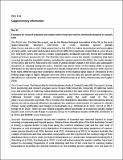Por favor, use este identificador para citar o enlazar a este item:
http://hdl.handle.net/10261/180611COMPARTIR / EXPORTAR:
 SHARE SHARE
 CORE
BASE CORE
BASE
|
|
| Visualizar otros formatos: MARC | Dublin Core | RDF | ORE | MODS | METS | DIDL | DATACITE | |

| Título: | Adaptive marine conservation planning in the face of climate change: What can we learn from physiological, ecological and genetic studies? |
Autor: | Rilov, Gil; Mazaris, Antonios D.; Stelzenmüller, Vanessa CSIC ORCID; Helmuth, Brian; Wahl, M.; Guy-Haim, Tamar; Mieszkowska, Nova; Ledoux, J. B. CSIC ORCID; Katsanevakis, Stelios | Palabras clave: | Marine spatial planning Ecological forecasting Climate change Mosaic distribution Physiology Adaptation Tipping points Vulnerability |
Fecha de publicación: | ene-2019 | Editor: | Elsevier | Citación: | Global Ecology and Conservation 17: e00566 (2019) | Resumen: | Rapid anthropogenic climate change is a major threat to ocean biodiversity, increasing the challenge for marine conservation. Strategic conservation planning, and more recently marine spatial planning (MSP) are among the most promising management tools to operationalize and enforce marine conservation. As yet, climate change is seldom incorporated into these plans, potentially curtailing the effectiveness of designated conservation areas under novel environmental conditions. Reliable assessment of current and future climate change threats requires the ability to map climate-driven eco-evolutionary changes and the identification of vulnerable and resistant populations. Here we explore the heretofore largely unrecognized value of information gained from physiological, ecological and evolutionary studies to MSP under ongoing climate change. For example, we explore how climate threats do not necessarily follow latitudinal gradients, such that both risk hotspots and refugia occur in mosaic distributions along species ranges - patterns that may be undetectable without knowledge of biological vulnerabilities at regional and local scales. Because co-occurring species can exhibit markedly different vulnerabilities to the same environmental changes, making ecological predictions requires, when possible, measuring the fundamental niches of key species (e.g., with the use of thermotolerance experiments). Forecasting also requires development of tools to identify the likelihood of community-level thresholds or tipping points (e.g., with the use of near-real world mesocosms), and assessment of the potential of populations for adaptation (e.g., with common garden experiments). Such research will facilitate better predictive models for the fate of populations, species, ecosystems and their functions. Ultimately, unfolding the complexity of the processes underlying climate change impacts will facilitate quantifying and reducing uncertainty in spatial planning decision processes and will enable the development of practical tools to validate adaptive conservation strategies | Descripción: | This article is based upon ideas developed in a workshop in Brussels in March 2017 organized as part of the COST Action 15121 ‘Advancing marine conservation in the European and contiguous seas [MarCons; www.marcons-cost.eu; (Katsanevakis et al., 2017)] - supported by European Cooperation in Science and Technology (COST, CA15121).-- 15 pages, 3 figures, supplementary data https://doi.org/10.1016/j.gecco.2019.e00566 | Versión del editor: | https://doi.org/10.1016/j.gecco.2019.e00566 | URI: | http://hdl.handle.net/10261/180611 | DOI: | 10.1016/j.gecco.2019.e00566 | Identificadores: | doi: 10.1016/j.gecco.2019.e00566 e-issn: 2351-9894 |
| Aparece en las colecciones: | (ICM) Artículos |
Ficheros en este ítem:
| Fichero | Descripción | Tamaño | Formato | |
|---|---|---|---|---|
| Rilov_et_al_2019.pdf | 530,21 kB | Adobe PDF |  Visualizar/Abrir | |
| Rilov_et_al_2019_suppl.pdf | 264,19 kB | Adobe PDF |  Visualizar/Abrir |
CORE Recommender
SCOPUSTM
Citations
79
checked on 07-abr-2024
WEB OF SCIENCETM
Citations
76
checked on 18-feb-2024
Page view(s)
220
checked on 22-abr-2024
Download(s)
260
checked on 22-abr-2024
Google ScholarTM
Check
Altmetric
Altmetric
Este item está licenciado bajo una Licencia Creative Commons



